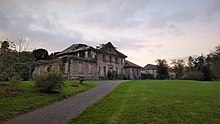National Botanic Gardens, Kilmacurragh
52°55′46″N 6°08′52″W / 52.929327°N 6.147796°W / 52.929327; -6.147796
The National Botanic Gardens, Kilmacurragh (Irish: Garraithe Náisiúnta na Lus, Cill Mochura) is a garden and arboretum outside Wicklow Town, County Wicklow, Ireland. It is a satellite of the main National Botanic Gardens located in Glasnevin, County Dublin. The 52 acre gardens are situated 5 km from exit 18 on the M11 motorway.
The gardens were founded in 1712 as part of the Acton family estate who owned the land until 1940.[1] Today, the gardens are in State ownership through the Office of Public Works. They were acquired in 1976 by the Land commissioner and day-to-day management transferred to National Botanic Gardens in 1996.
History
The story of Kilmacurragh stretches back beyond the establishment of the gardens to early Christian times when Saint Mochorog established a hermitage in the 7th century. A lake, part of which remains as a small pond, once existed as a fishing pond for a monastery that stood where the remains of the Acton family home stand today. This monastery was dissolved by Henry VII and the lands gifted to Thomas Acton I in lieu of wages.
Thomas Acton II (1655-1750) tore down the remaining monastery buildings in 1697 and used the stone to build the centrepiece Queen Anne style house. This house was one of the first unfortified houses of the time in County Wicklow and, while today it is in ruins, it is one of the few remaining early panelled houses in Ireland.
Thomas Acton III (1742-1817) inherited the estate in 1779 and decided to change the name of the estate from Kilmacurra to West Aston in 1750. When Thomas Acton IV inherited the Estate in 1854, he reverted his grandfathers name change and changed the estate’s name to Kilmacurragh, misspelling the original Kilmacurra. [2]
Thomas Acton IV and his sister Jane Acton were behind establishment of the current gardens. By the time they inherited the estate, it was over 150 years old, they quickly set about modernising it. The subscribing to plant hunting expeditions and utilising contacts in botanical gardens and nurseries around the globe to acquire exotic seeds for the gardens. The gardens were the showpiece of the rare Irish Queen Anne style house, the home of the Acton family.
The Rhododendron walks were developed through a friendship with David Moore the curator of the National Botanic Garden's at Glasnevin. This led to Kilmacurragh becoming the home to the national rhododendron collection.[3]
Further Kilmacurragh, whose acidic brown soil, low rainfall and mild winters, become the home of many specimens that were struggling or failing at Glasnevin. Many of the species grown in the gardens are so rare that they may be the only one or two of their kind in Europe or even the Northern Hemisphere.

These rare species include[4]
- Monkey puzzles (conservation status endangered)
- Chilean Laurel
- Tiger-tailed spruce
- Wellingtonia tree
- Campbell's magnolia
- Mexican cypress

The house was abandoned in the 1920s but was later run as Kilmacurragh Park Hotel by Charles Budina. An ownership dispute led to the abandonment of the gardens until it was acquired by the Irish state in 1976.[5]
In 2021 it was announced that funds would be made available to restored the house under the national development plan[6] and in late 2023, planning permission was granted for these plans which will include reinstatement of the building's roof, restoration of its windows and doors, and the conservation of the external wall finishes.[7]
Facilities

A café, Actons, opened in 2015 in one of the restored courtyard buildings on site.[8] During the summer months there are free guided tours by the team working to restore and replant the gardens.
References
- ^ "National Botanic Garden at Kilmacurragh – Wicklow County Tourism". Visit Wicklow. Retrieved 21 April 2019.
- ^ "History | National Botanic Gardens of Ireland". Retrieved 21 November 2022.
- ^ "Kilmacurragh Home | The National Botanic Gardens of Ireland". Retrieved 6 July 2019.
- ^ Thompson, Sylvia. "Kilmacurragh Arboretum: Ireland's secret garden". The Irish Times. Retrieved 6 July 2019.
- ^ Thompson, Sylvia. "Buildings at risk: Kilmacurragh House, Co Wicklow". The Irish Times. Retrieved 6 July 2019.
- ^ Society, Irish Georgian. ">Kilmacurragh House will be renovated under the renewed National Development Plan!". IGS Craft (en-IE). Retrieved 10 January 2024.
- ^ "Plans to restore Wicklow's Kilmacurragh House take big step forward". Independent.ie. 18 October 2023. Retrieved 10 January 2024.
- ^ "Acton Café | The National Botanic Gardens of Ireland". Retrieved 6 July 2019.
52°55′46″N 6°08′52″W / 52.929327°N 6.147796°W / 52.929327; -6.147796
- v
- t
- e
 Geography of County Wicklow
Geography of County Wicklow| Special Areas of Conservation |
|
|---|---|
| Special Protection Areas | |
| Nature Reserves | |
| National Parks |










